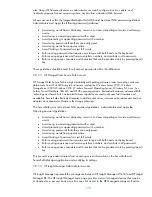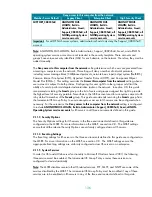
123
The
SNMP Service
allows incoming SNMP requests to be serviced by the local computer. The
SNMP
Service
includes agents that monitor activity in network devices and report to the network console
workstation. There are no requirements or dependencies in the three environments for the
SNMP
Server
. Therefore, this service is configured to
Disabled
in the three environments defined in this
guide.
Task Scheduler
Service Name
Member Server
Default
Legacy Client
Enterprise Client High Security Client
Schedule Automatic Disabled Disabled Disabled
Important:
This service must be set to
Automatic
if administrators are using Ntbackup.exe for
scheduled backups. This service must be set to
Automatic
on HP NAS server systems using
applications or services requiring task scheduler functionality. For example, various snapshot
applications, such as Microsoft Shadow Copy, use the task scheduler service to take snapshots of a
volume or volumes at a particular time, especially within cluster environments.
The
Task Scheduler
system service enables administrators to configure and schedule automated tasks
on the computer. The Task Scheduler service monitors whatever criteria administrators choose and
carry out the task when the criteria have been met. This service is not a requirement for the baseline
server policy. Therefore, this service is configured to
Disabled
in the three environments defined in this
guide.
Telnet
Service Name
Member Server
Default
Legacy Client
Enterprise Client High Security Client
TlntSvr Disabled Disabled
Disabled Disabled
Important:
This service must be set to
Manual
or
Automatic
on HP NAS server systems using telnet.
The
Telnet
system service for Windows provides ASCII terminal sessions to Telnet clients. This service
supports two types of authentication and four types of terminals: ANSI, VT-100, VT-52, and VTNT.
This service is not a requirement for the baseline server policy. Therefore, this service is configured to
Disabled
in the three environments defined in this guide.
Terminal Services
Service Name
Member Server
Default
Legacy Client
Enterprise Client High Security Client
TermService Manual Automatic Automatic Automatic
Important:
This service must be set to
Manual
on HP NAS server systems using terminal services
The
Terminal Services
system service provides a multi-session environment that allows client devices to
access a virtual Windows desktop session and Windows-based programs running on the server.
Terminal Services
allows multiple users to be connected interactively to a computer and to display
desktops and applications on remote computers. By default, the
Terminal
Services
system service is
installed in remote Administration mode. To install
Terminal Services
in Application Mode, use
Configure Your Server
or
Add/Remove Windows Components
to change the
Terminal
Services
mode.
Because this service is such a powerful tool for remote administration of servers, it is configured to
Automatic
in the three environments defined in this guide.
Note:
To prevent remote use of computers on the network, clear the
Allow Remote Assistance
and
Allow Remote Desktop
check boxes on the
Remote
tab of the
System properties
dialog box.
















































